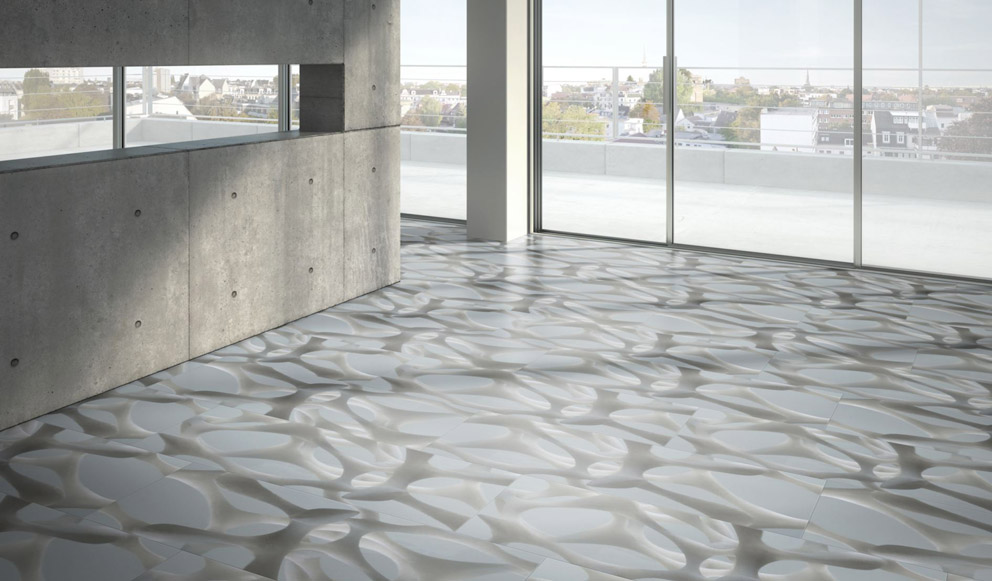Ross Lovegrove

“There is no problem for which nature has not already found a solution,” quips British designer Ross Lovegrove, who in his work relies on a mix of technology, materials research and organic shapes, and emphasizes that design can improve our lives. He can look back on a vast array of successfully marketed products, be it luminaires for Artemide, chairs for Moroso or even an auto for Renault. However, the Welshman does not only turn to nature for inspiration, but is likewise fascinated by traditional craftsmanship; perhaps this is the heart of his love of traditional floorings? Lovegrove, “Special Guest” at Domotex 2015, has long since transposed his futuristic design onto floors. In 2011 he designed two laminates for Parador that attest to his preference for biomorphic shapes and high-tech. In the one, aptly named “Circuit Board”, the look is modeled on an alienated computer ICB, while for “Bone Structure” he generated 3D osseous structures on screen, printed them out, and then photographed them.
Uta Abendroth: Ross Lovegrove, you made a name for yourself with high-tech design and all sorts of very futuristic objects. Can the method be applied to floor coverings?
Ross Lovegrove: Most certainly! My approach can be used because for each new project I start by doing detailed research and trying to understand what is actually being asked and is involved. The beginning is often a kind of philosophical discourse. Floorings also need to first be understood. For example, I could generate a 3D feel for a flooring in order to uphold my formal vocabulary.

At present, there’s a lot of talk about recycling and the use of classic or traditional materials for floors. Does that constrain your scope and creativity in general?
Lovegrove: No, not at all, as all materials are of relevance. It is true, however, that traditional materials are becoming important again, if only because they are eco-friendly and sustainable.
In your opinion, what it the greatest challenge: aesthetic advances or materials research? Or is the task at hand one of combining the two?
Lovegrove: I’m convinced that materials research and technology transfer advance the aesthetics and not vice versa.

There’s still room for trailblazing as regards flooring design. Who should be in the driving seat here, the designers or the manufacturers?
Lovegrove: That will only work if the two sides interact. Moreover, we need outsiders here, such as special research labs or university institutes. Innovations are the decisive factor driving growth and change in the sector. After all, there are large volumes involved because new residential properties are mushrooming worldwide and they all need flooring of one kind or another.
In this context what role do architects play? Can they raise awareness of the issues?
Lovegrove: I’m convinced they can. Architects are key figures when it comes to combining functions and aesthetics on very large-scale projects. Who if not they could from the outside urge developers to go for quality in terms of visual appearance, materials and finishing?
Floorings are a key part of any building. What should the architects think about first when choosing a floor covering?
Lovegrove: Very many different aspects play a role here. First there is the aesthetics, of course. Then the definition of different zones, where people mainly walk, where they stop and chat, and so on. And then there are classic factors such as acoustics, atmosphere, ease of care – and the cost of course.

How strongly do culture-specific customs inform the choice of flooring? Can one influence traditions and preferences?
Lovegrove: Climatic conditions and cultural habits are nuances that can help us explore new products. The focus must be less on changing preferences and more on using innovations to improve the quality of life. In the UK, the climate tends to be damp and cool, buildings outdated. Heated carpets available on any scale would be a great solution, precisely for the start-up offices usually found in simple buildings or old factories – and for traditional homes, which in Britain tend to be pretty basic and are hard to heat. That would be a great product, easy to retrofit in buildings for use in very specific spaces.
Last but not least, which flooring do you prefer?
Lovegrove: I love handmade carpets with a pronounced mathematical geometry like the ones made in Persia using natural materials such as silk or wool. And I also love sand under my bare feet or the typical wooden floors of a Japanese ryokan guesthouse – they massage your feet gently when you walk around on them.
MORE on Stylepark:
Floors to fit: The Domotex in Hanover showed the full reach of what flooring can do today.
(20 January 2015)






















